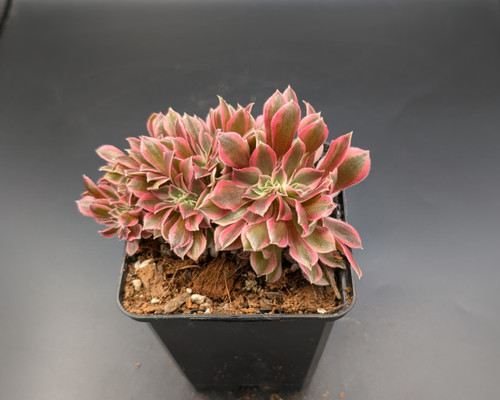Pot Size: 3.5"
Accepted Scientific Name: Aeonium ‘Loki’ Crested
Origin and Habitat:
Aeonium ‘Loki’ Crested is a cultivated mutation of an Aeonium hybrid, thought to derive from Canary Islands species that naturally inhabit rocky volcanic slopes and coastal cliffs. These regions provide mild, maritime conditions with low rainfall, well-drained mineral soils, and frequent mists that encourage compact, symmetrical growth. The crested form develops through fasciation, where the growing point elongates and produces an undulating, fan-like shape rather than single rosettes. This unique morphology makes Aeonium ‘Loki’ Crested a prized ornamental among succulent collectors.
Description:
Aeonium ‘Loki’ Crested forms densely packed, undulating fans of rosettes fused along a central crest. The leaves are fleshy, slightly pointed, and range in color from bright green to bronze, deepening under strong light. Each crested segment creates a sculptural wave effect, making it appear alive and flowing. Plants typically reach 4–6 inches (10–15 cm) tall and spread 10–14 inches (25–35 cm) wide. Flowers are infrequent but, when present, are small, star-shaped, and yellow, emerging from mature areas of the crest.
Cultivation:
Zone: 9–11
Temperature: Optimal range 10–25°C; protect from frost below 5°C.
Growth Rate: Moderate; slower than standard forms due to compact, crested growth.
Soil: Use a porous mix with pumice, perlite, and loam for strong drainage and aeration.
Watering: Water lightly during growth, allowing the mix to dry between applications; keep nearly dry in dormancy.
Fertilizing: Feed with a balanced succulent fertilizer every 2–3 weeks during active growth.
Light: Prefers bright, indirect light or gentle morning sun; avoid prolonged exposure to harsh afternoon sun.
Pests and Diseases: Susceptible to mealybugs and root rot if overwatered. Maintain good ventilation and avoid water pooling in crested folds.
Propagation:
Propagate from crested cuttings or divided sections. Let cut ends callus for several days before placing in a well-draining substrate.





